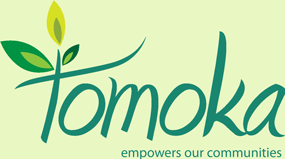
PROJECT “TSO MIA WO DEKA”
LET’S JOIN HANDS – COOPERATION
TOGOLESE PROVERB (of the Kabye People):
Dudoyo nebese nabeyu = One by one makes a bundle
INTENTION
FOSTERING SUSTAINABLE RURAL DEVELOPMENT IN THE CANTON OF DAWLOTU TUTU
BY PRODUCING <FOOD & BIO-ENERGY> WITH A HYBRID FORM OF THE JATROPHA SYSTEM AS ITS MOTOR
ABBREVIATION
Tomoka
CONTENTS
- Extremely poor Target Group
- High development potential
- Two Partners joining hands: GuKam & The Community
- Common grounds
- Strategic location
- Preliminary start
- Temporary Project Team
- Organisation
- Tomoka and Togo’s National Development Strategies
- General Objectives
- Four Action / Intervention Programmes
- Interrelated Objectives and Targets – examples
Extremely Poor Target Group
Tomoka’s Target Group presents itself into more detail elsewhere on this website – see Our Community. The rural, thinly populated area we are dealing with is traditionally defined as the Canton of Dawlotu Tutu, about 150 km to the North of Lomé, between National Roads 5 and 9. It is environmentally characterised by fast deforestation on rather flat land at an altitude ranging from 200 to about 500 metres, surrounded by hills. Exact maps are not available at this moment. The Canton’s area is assumed to be more or less 45 x 50 km. There is good reason to believe that the National Government will publish detailed maps in the nearby future.
Reliable census and other social-economic data are not at hand, but it is clear that the population should be classified as “isolated and extremely poor”. Estimates of the Canton’s multi-ethnic population range from 17.000 to 21.000. An estimated 80% of the population lives on far less than one dollar per day. Malnourishment and mortality of children under five and of delivering young women are rampant. Infrastructures like roads, electricity, potable water, sanitation, basic health care, education, police and representation of national government are absent or only present in rudimentary forms in the Canton’s ‘capital’: Tutu. Illiteracy amongst adults is high but nobody knows the exact percentages. An estimated 85% of the population lives from small-scale agriculture on farms between 1 and 3 hectares of land. Most of them are subsistence farmers who cultivate not more than 1,5 hectares. Their annual cash income from the sales of some sacks of maize, beans and the like does not exceed F CFA 150.000 . Most of the farmers with more than 1,5 hectares of land, have been producing cotton on small fields for wholesalers in the country’s capital. Many of them end up being heavily indebted, because the cost of their inputs (seeds, fertilizer and pesticides) advanced by those cotton dealers, surpass the amounts they eventually receive for their harvests.
The government’s representative, the “Préfet” of the Préfecture Agou, lives outside the Canton. He can be called upon for support concerning matters of Law and Order. Civil services of a municipality do not exist. The nearest town hall is situated in Kpalimé, about 30 Kilometres away. Travelling to this small city can take place by moto-taxi. But the costs are prohibitive. They vary between F CFA 2.300 and 3.100 (the equivalent of € 4,73) for a one-way trip -- far more than the individual, average Canton dweller is able to spend per month…
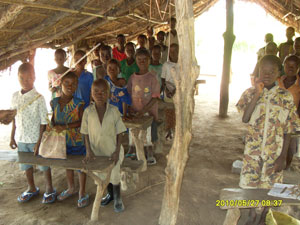 |
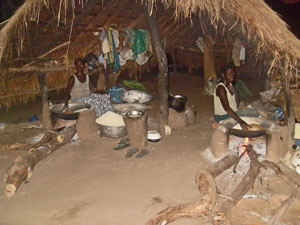 |
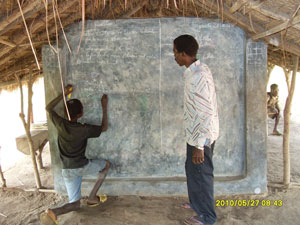 |
||
School in Avégamé – an initiative by the local farmers. They also finance and maintain it |
RURAL ENERGY.......these tree branches provide the energy for roasting of only one large portion of gari......FORESTS DISAPPEAR in high speed! |
School in Avégamé -- the teacher looks forward to more teaching aids. But the farmers who finance this school cannot afford this yet… |
||
High development potential
Despite the poverty sketched above, the Canton possesses a high potential for social-economic development. The community has a well defined and well-functioning organisational and leadership structure of 9 villages which are coordinated by a Canton Council of Elders and the Chief of the Canton, Togbui Akuagbi III. He represents the highest authority in the Canton, and is acknowledged in this capacity by the National Government. The Canton Chief’s prime responsibility is the coordination and formal approval of the policies of his nine (educated) village chiefs who have their own Council and a Village Development Committee (abbreviated in French as CVD). The latter is made up of local volunteers. Land rights and most other important issues are dealt with on this local, village level.
The depicted form of Traditional Leadership is functioning well, and is accepted by all ethnic groups. Most self-help and other initiatives are taken by the Village Development Committees which appear to encourage women in particular to organize themselves into small groups with common income generating objectives like mat weaving and the production of cooking oil.
Another important feature of the population is the high priority they place on education for their children. Nine primary schools have been created and are maintained by the local farmers themselves. About 800 children attend classes here. A slightly higher number of children goes to public schools financed by the state, and the Catholic church provides education to another 635 children. Most rural, open-air schools have locally produced school benches, fixed in the ground. Books and other teaching aids are not yet affordable.
The actual labour force – men and women between 16 and 50 years – is estimated to be around 40%. This percentage jumps up every year because Togo’s population is very young: 43,3% is even younger than 15 years!
Another attractive aspect of the Canton is its small but increasing awareness of the need to stop deforestation. And last but not least: the local leaders have the power to make available vast areas of fertile, unused land which are suitable for projects like Tomoka whereby environmental preservation and rehabilitation go hand in hand with income generation in the form of producing Food and Jatropha seeds (for bio-energy) while local agro-industries will process both.
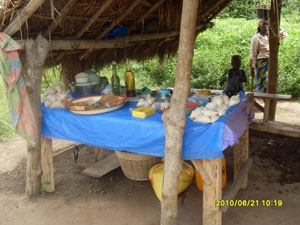 |
 |
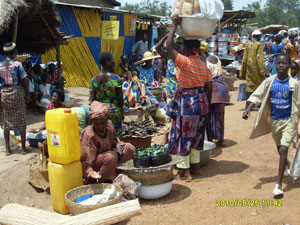 |
||
A local shop in Tomoka’s Project Area. |
The Queen (left from the throne) and her companions have the final say in most occasions of importance – an aspect of local culture which facilitates initiatives in the field of women empowerment |
Market day in Kati, just outside the Canton.. |
||
Two Partners joining hands: GuKam & The Community
In line with GuKam’s commitment and mission ”to create wealth within the most impoverished rural areas of Togo” the Company has approached the Leaders of the Canton of Dawlotu Tutu to find out whether they would cooperate. The Tomoka Project is the outcome of a series of meetings whereby it became clear that the Canton and GuKam have slightly different but supplementary and interdependent needs and objectives: The Community’s highest priority is the acquisition of an impulse for sustainable economic development which should lead to all kinds of other improvements of the quality of rural life. And GuKam needs suitable land, skills and manpower for its agricultural, bio-energetic and agro-industrial plans. Both Parties agree that these two needs coincide: they are in perfect harmony with each other and can only be fulfilled when both parties work together. Hence the Project’s full name: “Tso Mia Wo Deka” which means literally “let us join hands – let’s work together”.
In October 2009 GuKam and the Community of Dawlotu Tutu signed an Agreement to cooperate for the production of food and bio-energy and for the future agro-industrial processing of such feedstock. Its terms reflect this insight and desire. They moreover present the first pragmatic steps for the preparation of the funding of the foreseen activities.
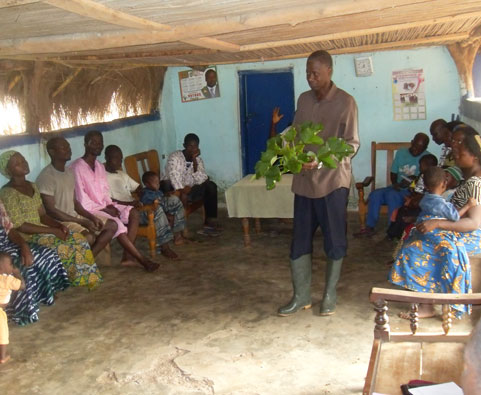 |
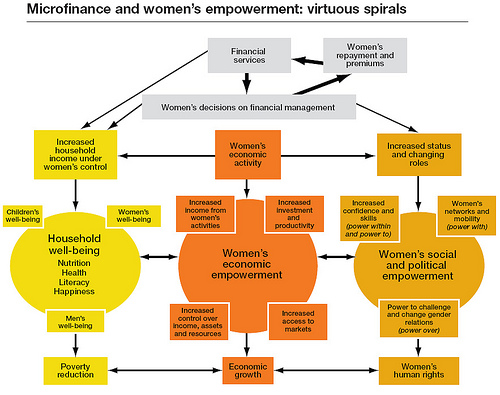 |
|||
Many women usually attend Jatropha demonstration sessions like this one provided by GuKam director Amégadzé -- with a view to their future participation and ownership in the planned Insertion Program |
The TOMOKA Project explicitly aims at women’s economic empowerment in the context of all Projects in the Agricultural and the Agro-industrial Programme |
|||
Common grounds
The Implementation of the Hybrid form of the Jatropha System which GuKam has conceived and worked out into further detail, defines the common grounds of the Project: all agricultural activities concentrate on Food Production and on the cultivation of plants (Jatropha) which will deliver the Feedstock for Bio-energy while contributing to a better natural environment at the same time. This will create many new farms and jobs. The more so since all agro-industrial activities will also be situated in the Canton itself. The population will process its own produce. The increased income generated this way will enable a continuation of the upward development spiral which has set in with agriculture. It will enable the local producers to become the consumers of their own produce and of their new products like bio-carburant, soap and easy to prepare staple foods. And the resulting surplus incomes will generate new entrepreneurial activities. Sales to clients outside the Canton will accelerate this economic growth even more.
With a view to the Canton’s isolated position, lack of telecommunication, scarce administrative and managerial capabilities, and the absence of capital, GuKam has agreed to cooperate with the Community as a full partner and to pre-finance the preparations and preliminary start of this Project. Tomoka’s organisation format reflects this. Together, both parties will reach out to national authorities and to all other organizations in the fields of sustainable rural development, the Jatropha System, financing and related domains. This website is one of the ways by which we hope to inform those institutions and raise their interest.
Strategic Location
The Canton is situated in the Region “Plateaux” -- not far from urban areas where most of Tomoka’s future clients are living. This is important for the future sales of baby food and other foodstuffs. Another strategic aspect of locating Tomoka in the Canton of Dawlotu Tutu is the quality of its soil. The degradation map shows that the soil is called <slightly degraded>, despite the overwhelming deforestation which took place. A reasonable soil quality will facilitate the cultivation of Food and Jatropha. And good harvest will certainly convince third parties of the effectiveness of this Hybrid Jatropha System. Moreover, the administrative, agricultural and agro-industrial headquarters of the Project will be situated in the middle of the Canton, near the hamlet of Avégamé which falls under the jurisdiction of the Chief of the Zone of Kpékpéta. The chosen location is one of the few places with access to a mobile phone network. However, there is no electricity or water nearby. But the Project Site can be reached with a rural road (piste) which is navigable most of the time. It connects to all other major dirt roads by which products and services will be distributed to the villages and hamlets of the Canton. There is a capable young labour reserve, and the local Chieftaincy appears to be able to motivate and mobilize the population for the common good. And last but not least for a development project that is based on agriculture: the Kpékpéta Zone is able to satisfy the land needs of the project right away by providing more than 1000 hectares of suitable, unused land which has suffered from deforestation. From here the Project is able to branch out to adjacent zones where another five to six thousand hectares of similar land can be added in the future.
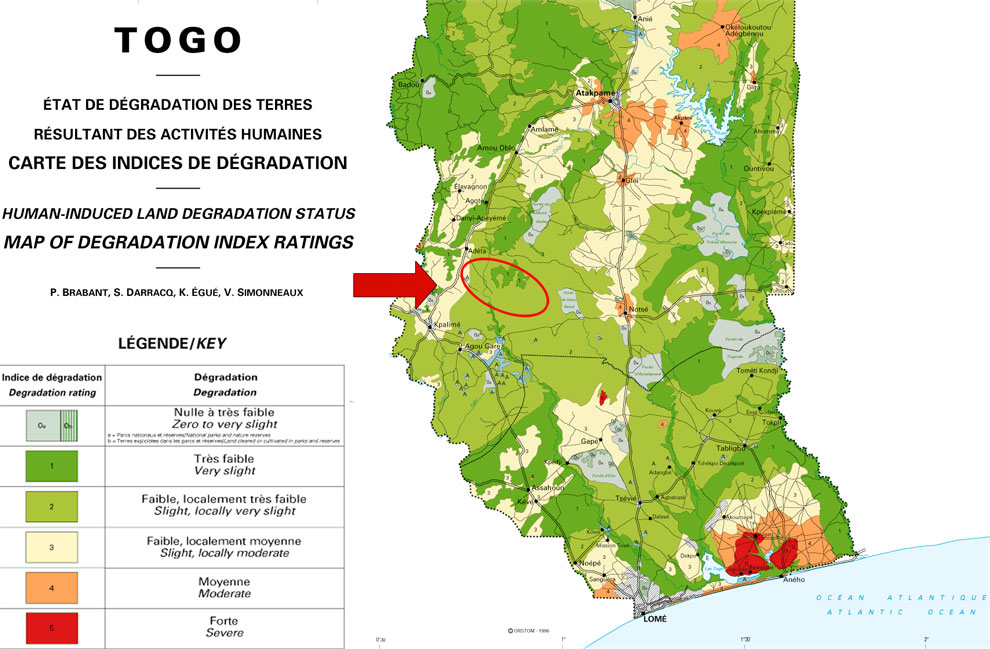
Preliminary start of the Project
In March 2010 GuKam has constructed its Pilot Plantation on 6 hectares of land near the hamlet of Avégamé, the centrally located area discussed above. This early investment was unavoidable. Prior to the start of the Tomoka Agriculture & Agro-industrial Programmes, it is necessary to possess sufficient quantities of High Quality Jatropha Propagation Material that is adapted to the local soil and climate conditions. It takes several seasons to develop such seeds for the 630 hectares of land which ultimately will be planted with this feedstock for Tomoka’s bio-energy production. Equally important is the development of empirically tested Best Agronomic Practices which the Pilot Plantation will deliver. Its central location will come in handy when those agronomic practices for Jatropha and its intercropping with staple foods, have to be disseminated to the local farmers.
Prior to the Pilot Plantation, GuKam has created a rudimentary ‘Banque de Semence et Boutures (BSB)’. This Jatropha Propagation Bank contains seeds and cuttings from high yielding wild Jatropha Plants. Seeds which have passed a germination test score of 80% (and cuttings stemming from the same mother plants) have been used to start the experiments and multiplication efforts on 5 hectares of land of the Pilot Plantation in Avégamé. Records are kept in the temporary field office which GuKam has built on the ‘Service Area’ of the Pilot Plantation. This area of 1 hectare has been reserved for the nursery, store and future buildings.
A small multi-purpose office & training facility will have to be created on the same central location -- the sooner the better. The staff of this future Office has to get the Tomoka Project from the ground, and will work out the details of its policies and financing. Meetings and Training sessions for the farmers, women groups and the project’s Steering Committee will take place there too. In anticipation of such a Project Office, GuKam and the Chieftaincy of the Canton have set up a Project Steering Committee: the CVD-P (named after the French initials of its full name: Comité Villageois de Développement pour le Projet). All preparation work takes place on two locations: administrative affairs are being dealt with in GuKam’s own office in Lomé. Policy making takes place in the Project Area itself: in the village of Kpékpéta where the local Chief and his Council are residing. The Chief’s meeting hall has been made available for these important bi-weekly meetings. Approbation of Plans and Policies takes place in sessions with the Chiefs.
Three plans for inserting local farmers in the agricultural program have been discussed in the CVD-P already: The Implementation & Production Scenario lies at the basis of all agricultural and agro-industrial production. The so called Insertion Plan provides the details of how and when 100 new small-scale farms may be created. The adoption of the final Scenario in June 2011 implies the creation of at least 180 small new farms of 5 hectares each – predominantly for the settlement of landless migrants from the North. And the document on Jatropha Hedge Planting makes clear how and when 300-500 existing subsistence farmers will join the program.
Soap making experiments have taken place as well. They were meant to help Tomoka prepare its plans for a small Soap Laboratory (Savolab) which will produce and test the recipes for the rural and urban soaps which will be produced by women groups in the Canton. A preliminary document sketches the functioning of this Savolab and some details of a Consumer Test Panel which will be needed for tryouts of the planned rural soaps and the luxury varieties for European markets. The latter will be produced in a small semi-artisanal Atelier managed by GuKam, and is expected to create another 20-25 new jobs for women in particular.
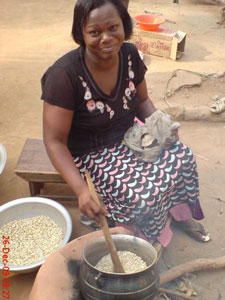 |
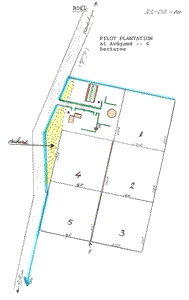 |
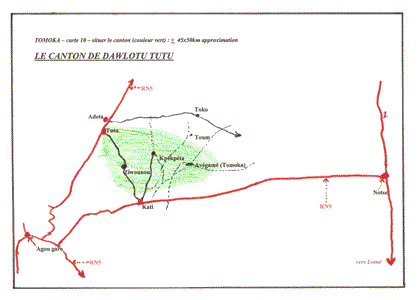 |
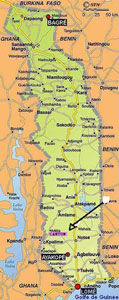 |
|||
Jatropha Oil is being extracted in the traditional –wood consuming –way. |
Layout of GuKam’s Pilot Plantation in Avégamé where High Quality Seeds and Best Practices are being developed |
The Pilot Plantation is situated near the hamlet of Avégamé (Zone Kpépéta) – in the centre of the Canton of Dawlotu Tutu. |
The Canton is centrally located: not far from major markets |
|||
Temporary Project Team
The temporary Project Team reflects the tasks of the future Project office. It is meant to support the Steering Committee (CVD-P) with its multitude of preparation tasks. The daily team consists of a secretary, bookkeeper, and agricultural officer. They work part time for the Tomoka Project. Management is provided by one of GuKam’s directors, Mr Gu-Konu, who has been putting in a half time job from September 2009 onwards. The other director, Mr Amégadzé, has been making available 25% of his time. Both GuKam directors have a seat in the Tomoka’s Steering Committee CVD-P. Tomoka’s Temporary Project Team has also collected extensive documentation on the cultivation and processing of Jatropha, has started Soap Making Experiments, and has set up an Image Bank with homemade photos which will feed the promotion and training efforts of the Project. But the Team’s most important contribution to the functioning of the Project lies in the field of policy preparations and the production of ‘handbooks’. Such documents are being discussed in Tomoka’s Steering committee CVD-P and deal with core issues like the gradual extension of the surface which will be cultivated by staple food and Jatropha, the insertion of new farmers into the agricultural production program, crop expectations, and the development of different kinds of soap which will be produced by the Canton’s women and by Gukam.
In line with GuKam’s core values the company takes care of the financing of the project preparations – up to a maximum of F CFA 20 million (equaling more than E 30,000), at its own risk. This amount includes F CFA 5 million for GuKam’s own participation in the Tomoka Project. Tomoka’s first Foreign Partner, the Dutch Foundation Stichting Tomoka Support, has joined the starting-up process in January 2011, and has contributed almost F CFA 4 million and free expertise. The Project Steering Committee (CVD-P) understands and accepts that the pre-financed amount is very high for a small company like GuKam. That is why it will investigate how and to which extent these starting costs will be paid back, or can be earned back when the Project gets off from the ground with external funding.
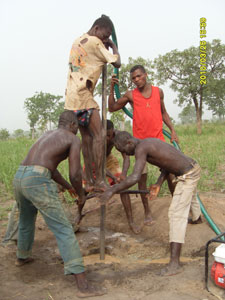 |
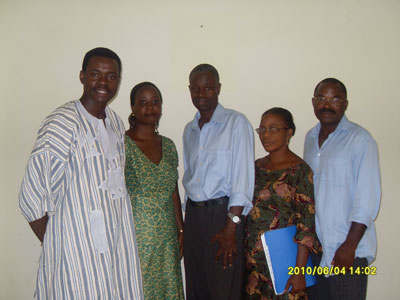 |
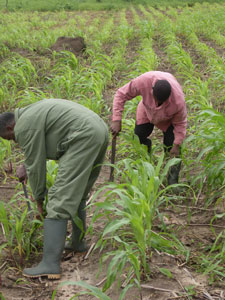 |
||
STRATEGY: we start with concrete, attractive improvements. Here the first water well is being drilled...and our people talk about it!! |
PEOPLE: we are the members of the Temporary Project Team. We are financed by our own company during the preparation and starting up of the Tomoka Project.....and our people appreciate this! |
STYLE: we love to make our office hands dirty. After all, agriculture is the basis of the Project. .....and our people understand that we are them! |
||
Tomoka’s Organisation
Tomoka is in the process of registering as a non profit, non governmental organization (NGO). In line with national requirements for rural development, a special Village Development Committee has been set up for the Project. This Project Steering Committee is referred to as CVD-P, after its French initials, and will become the Board of the new NGO. The Canton and GuKam are the two Parties who make up this policy making entity. There are 11 members: five seats are reserved for representatives of the project area, four for the Canton as a whole, and GuKam occupies the two remaining seats. GuKam is also represented in the Executive Board of the CVD-P where it occupies one of its four seats. Decision making in this Executive Board is by consensus; in the CVD-P by majority vote. The Board Members are receiving appropriate training in order to upgrade their policy-making and management skills.
The interests of Kpékpéta, the zone in which the Tomoka Project will be situated, are decisive for all policies. That is why the Kpékpéta Zone delivers most Members of the CVD-P. All major Policies and Implementation Plans need the approbation of the Chieftaincy because they are the representatives and guardians of the communally owned land and customary law. In Tomoka’s case Togbui Dzéto, the Chief of Kpékpéta, and the Superior Chief of the Canton, Togbui Akuagbi III, will officially authorize the policies, plans and contracts. They will also exercise their customary legal powers if conflicts arise, or if sanctions have to be taken when contract partners do not comply with what has been agreed.
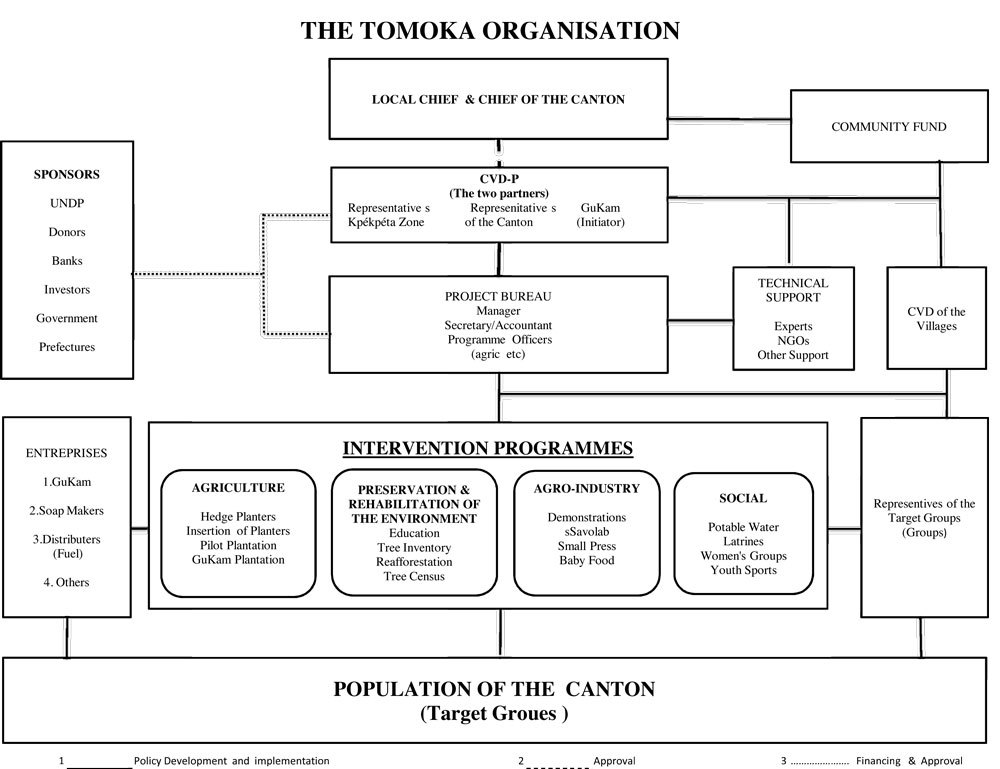
The Organogram presented above shows that Tomoka’s Project Office is responsible for the preparation and implementation of all development plans which the CVD-P has adopted and which have been approved by the Chieftaincy.
During the starting up phase of the Project (2009-2012) only some staff have been hired: a half-time manager provided by GuKam, and three part-time assistants who will be fully employed when funds become available: a secretary-accountant, a community worker, and an agronomist. Their combined competencies seem sufficient for the period at stake here. At a later stage it should become clear to which extent each of Tomoka’s four Intervention Programmes will need a Program Officer.
External funding and expert resources for this sustainable rural development project are still unknown. That is why they are only vaguely referred to. At a later stage – hopefully somewhere before the end of 2011 – it will become clear who exactly will be Tomoka’s Partners-in-Development. The Promotion and Fund Raising Campaigns which have started during the last quarter of 2010 have already lead to a somewhat clearer picture. It has resulted in a Dutch initiative to send a Dutch Expert in December 2010. His report about a one-month lasting Fact Finding Mission has resulted in the fostering of a new Dutch Foundation by professionals, exclusively for the support of our Project. Hence Tomoka’s first Foreign Partner, is called Stichting Tomoka Support.
The Four Action / Intervention Programmes presented in the above Organogram form one integrated set of interventions which intend to realize the Project’s general objectives. Each intervention program has been broken down into relatively small, manageable projects with clear, concrete and measurable targets which have to be realized in a clearly defined period of time. Our Project List provides all details. This concrete way of working is most appropriate for Tomoka’s Target Groups. And it fits well with the “motor function of the Hybrid Jatropha System” which the Tomoka Project has adopted as its guiding development methodology. That system of principles, practices and procedures is explained into further detail on this website in the section which deals with the contributions of the Jatropha System to sustainable rural development. More details of the planned four action programs are presented in the Project List itself and in the sections below. Here we just point out that they are so to say the ‘four wheels of the development vehicle’ by which the population will be organized, receive relevant trainings, will produce food and bio-energy, improve the natural environment, and will increase its standard of living and well-being.
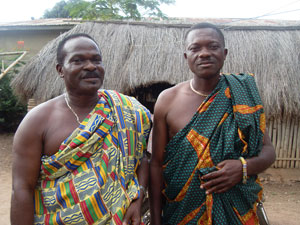 |
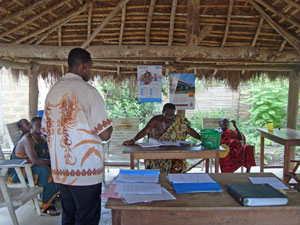 |
|||
The two Chiefs involved in the TOMOKA Project : |
GuKam director Kodzo Gu-Konu (standing) addresses the Canton’s Chief during the official Inauguration of the Project Steering Committee (CVD-P) |
|||
Tomoka & Togo’s Development Strategies
Togo’s national development strategies are inspired by and participate in the worldwide efforts which are taking place under the umbrella of the United Nations Program called Millennium Development Goals (MDG). That is why the Tomoka project will explicitly go forwards by contributing to the Government’s national strategies in many ways. One way of doing this, is to focus foremost on the eradication of extreme poverty and hunger (MDG 1), like Togo’s Government does. The most practical way of realizing this objective, forms the core business of the Tomoka project. In a country like ours, where most people live in rural areas, the new economic activities will focus on the production of Food & Bio-Energy by our farming communities. Against this background it is clear why Tomoka has also adopted a policy to contribute to the preservation and rehabilitation of Togo’s natural environment. That environment forms the habitat of most of Togo’s inhabitants, and is the basis of its rural economy. The dramatic deforestation in the Canton of Dawlotu Tutu where Tomoka is situated, is threatening that basis. Within a period of only 15 years the heavy forests have disappeared altogether. The big trees have been turned into rural energy (fire wood and charcoal), and farmers lack means and knowledge to prevent erosion and further degradation of the soil. This is an alarming trend which has to be stopped nation wide, because it threatens to undermine many of Togo’s development efforts and the national food security.
But there is more to Tomoka’s interventions. Its four Action Programmes go much further than ‘food and bio-energy production’ and the preservation of the natural environment. The intervention programs are designed in such a way that they form a combined, explicit effort to contribute to the realization of three interacting Development Goals. In terms of the Millennium Development Goals they are MDG 1, 3 and 7. They intend respectively to Eradicate extreme poverty and hunger (MDG 1), to Promote gender equality and empower women (MDG 3), and to Ensure environmental sustainability (MDG 7).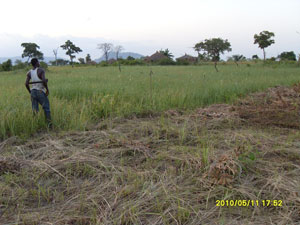 |
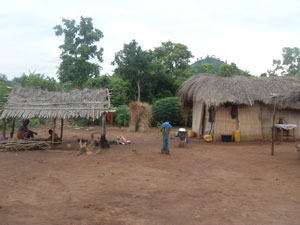 |
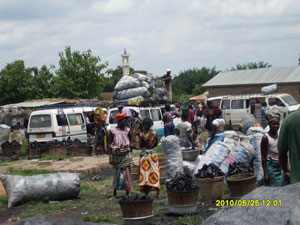 |
||
DEFORESTED landscape : on the Pilot Plantation before the hamlet of Avégamé |
FIREWOOD is the only source of rural energy for 80% of the Canton’s population - kitchen on the left |
CHARCOAL markets like these in Kati consume the Canton’s last big trees |
||
And last, but not least: the Tomoka Project provides many macro-economic advantages: the national imports of expensive petrochemical products will go down, the government will obtain more revenues from taxation of the Canton’s increased incomes and economic activities, contributions to the national food security make imports redundant, the rehabilitation of the natural environment creates the basis for continuation of sustainable economic growth in rural Togo, and the government will benefit directly and indirectly when Development Organizations like Tomoka and Private Companies like GuKam will be enabled to sell CO2 Emission rights on the international market because of the fact that the Hybrid form of the Jatropha System contributes significantly to a cleaner environment. All these savings and extra revenues will make sure that Togo’s government can spend more on its development priorities.
Tomoka’s explicit intention to make women empowerment a vocal and focal point in the Canton, deserves a bit more attention: The Initiators of this project (GuKam) are convinced that gender equality is an important variable in economic progress. Even more than that: it plays a central role. That is why several of the UN Practice Pointers in this field will be incorporated into Tomoka’s intervention programmes when the project will be staffed sufficiently. These practice pointers are based on lessons learned elsewhere, and have been reported extensively by the Millennium Development Goals (MDG) Program. Tomoka’s Initiator, GuKam, will see to it that the Project’s Steering Committee (CVD-P) will integrate gender equality in all of its Programmes. At this stage of the Project, three examples will illustrate this: The Project’s Steering Committee CVD-P will see to it that the new farmers, who will obtain land, will be men, women and even groups of women if they desire this. The existing women groups working on other people’s land, for example, could be turned into entrepreneurs themselves. Moreover, all land contracts between the CVD-P and farming families will not only be signed by their male Heads as is the tradition in the patriarchal culture of the Canton. All spouses will co-sign as well. Women, furthermore, will increasingly obtain positions in the frontline of the Project Organization, and men will team up with them in new activities like the sales of Jatropha Oil for cooking, light and powering diesel engines.
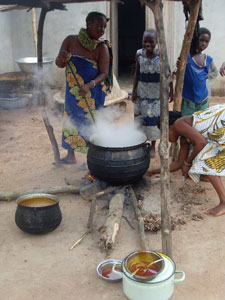 |
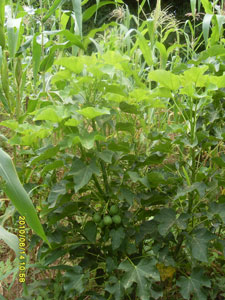 |
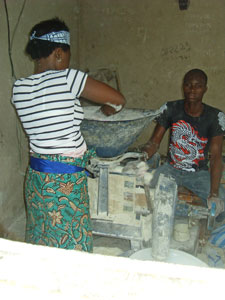 |
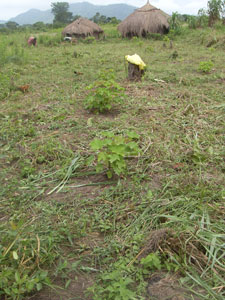 |
|||
Palm oil extraction in Tutu, the Canton’s capital. The rural energy needed for one litre of oil equals more than 3 x the amount of wood on this picture...!! |
Food & Bio-energy intercrops will improve sustainability of the rural economy: Maize and Jatropha on Experimental Field 3 in Avégamé |
Maize mill managed by women in Tutu: an example of empowering some women economically while reducing the household burdens of others |
<Best Agronomic Practices>: The experiments carried out on this Field will produce maximum Jatropha crops ......and affordable rural energy |
|||
General Objectives
The General Objectives of the Project are inherent to the fact that Tomoka aims at sustainable rural development by introducing a ‘Hybrid Form of the Jatropha System within the national development priorities’. Our approach is hybrid because it focuses on Food & Bio-energy production. And Tomoka intends to work within the vision and programmatic context of Togo’s National Development Strategy. That is why we build forward on the Rural Potential of the population of the Canton itself. Tomoka’s interventions, moreover, are efficiently integrated. They have been planned in such a way that they mutually support each other. This is explained into more detail in the following paragraph, and in the documents titled "overview & project list" which open each Program Section in the downloads.
Our general objectives intend to:
- Eliminate extreme poverty in the Canton
- Raise the average standard of living and quality of life – at first instance primarily by improving access to potable water and sanitation, by stimulating self-help, organization and community banking, and by improving the rural roads (French: pistes) and the storage facilities for local harvests (French :silos)
- Stimulate all kinds of local entrepreneurial initiatives directly linked to the production, agro-industrial processing and sales of locally produced Food & Energy
- Create energy self-sufficiency in the Canton by producing Jatropha Oil and briquettes made from Jatropha press cake as a sustainable, locally produced source of bio-energy for cooking, light, and diesel engines
- Contribute to environmental conservation and rehabilitation by planting Jatropha and useful trees, reducing tree cutting, bringing charcoal production to a halt, raising environmental awareness of the population, and by introducing cleaner fuel for trucks, cars and stationary diesel engines in and outside the Canton
- Promote women empowerment as an inherent aspect in Tomoka’s own Organization, and in all intervention programmes and in their projects
- Create new jobs and a better skilled labor force in agriculture, agro-industry, and supporting sectors like transportation, whole sale and administration.
- Contribute to Togo’s national food security and energy self-sufficiency, accompanied by conservation and rehabilitation of the natural environment in the Canton
- Provide macro-economic contributions to Togo’s National Budget by replacing Togo’s petrol imports with home-grown bio-carburant and (at a later stage) bio-diesel, reducing food imports, reducing the informal economic sector, and by the creation of opportunities to collect taxes-at-source within the improved economic activities of the Canton.
- Enable the national Development Organizations and Companies to sell Carbon Dioxide (CO2) Emission Rights on the international market.
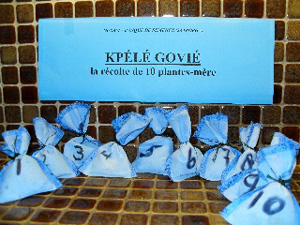 |
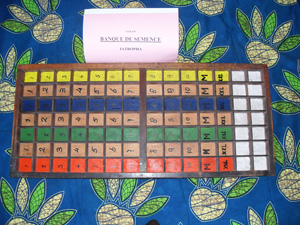 |
 |
||
JATROPHA SEED BANK (system) – The harvest of 10 High Yielding Mother Plants in the Zone of Kpélé Govié -- not yet sorted for perfection and size |
JATROPHA SEED BANK (system)– Seeds of 10 High Yielding Mother Plants in 4 Zones lie stored in such a way that each future plant on the Pilot Plantation can be traced to its origin |
JATROPHA SEED BANK (system) – The harvest of High Yielding Mother Plant K3 (left) and the High Quality Seeds selected for germination testing and propagation on the Pilot Plantation |
||
Four Action / Intervention Programmes
The four action programmes which have been presented in Tomoka’s Organogram form one integrated set of interventions which intend to realize the Project’s general objectives (link). Each intervention programme deals with one aspect in particular. And each of them has been broken down into relatively small, manageable projects which have clear, concrete and measurable objectives and targets which will be realized in a clearly defined period of time. In other words: the programmes are clusters of thematic Projects, and the four programmes are themselves interrelated in many ways. During the years 2009-2012 – the preparation and starting up years of the Project – most energy will be invested in the planning and small-scale start of essential projects. When external funding becomes available, these projects will be the first ones to be implemented.
Tomoka’s four intervention programmes are dealing with the following major aspects of the Project:
- Agriculture
The production of staple food and jatropha seeds -- the feed stocks for the new agro-industries – forms the economic basis
of all other plans. This program organises the farmers, and takes care of the production quota set by the Project’s agro-
industries and wholesale distribution of oil and new products like soap, baby food and easy to prepare foodstuffs. - Social aspects / Community Development
Sensitisation and the organisation of special interest groups (like women, youngsters, and farmers) & the community at large, are the major concerns of this program. In order to achieve this, concrete improvements of the quality of life will be realized. Examples are the construction of potable water provisions and latrines, the organisation and training of women groups, the formation of youth groups for sport and cultural activities which will animate life in the village, the introduction of rural banking, and the organisation of training programs which support the new economic activities. An example is a simple course in Profit-Loss accounting for women groups which will produce and sell Jatropha Soaps. - Environment
Awareness education and concrete environmental rehabilitation efforts will be at the centre of this program. Much attention
will be given to the integration of environmental care into the other three programs. An example which has already been
accepted by Tomoka’s Steering Committee is the idea that farmers will have to plant a certain number of useful trees on their homesteads if they want to qualify for support in the Agriculture Program. - Agro-industries
Local small-scale agro-industries will eventually process most of the Canton’s agricultural output. Jatropha seeds will be pressed in a centrally located Oil Mill operated by GuKam. The resulting oil and press cake will serve diverse objectives. A large part of the oil will be used as bio-carburant for cheap and clean light, cooking and diesel engines. Another part will be turned into household soaps (washing, anti-mosquito and body) in small Ateliers run by women groups, and in a larger Soap Atelier managed by GuKam in order to produce exportable soaps for luxury markets in Europe. A simple Soap Development Laboratory (SAVOLAB) will develop several ‘natural handmade soaps’. The press cake (also called seed cake) will be used as manure on the fields, and will increasingly be turned into briquettes which can replace wood and charcoal. The staple food crops will eventually feed Community Maize Mills, GuKam’s Baby Food Factory and Ateliers which will produce ‘easy to prepare meals’ which should lighten the household burdens of women in the cities.
Tomoka, moreover, aims explicitly at becoming slowly redundant. Transfer of skills and economic sustainability of all interventions will be built into many Projects. The rent which new farmers will pay for renting communal land, for example, will enter a Community Fund which increasingly will take care of creating and maintaining infrastructures.
 |
 |
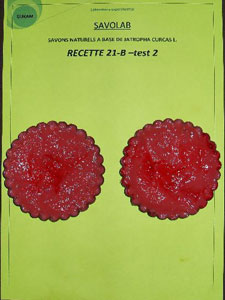 |
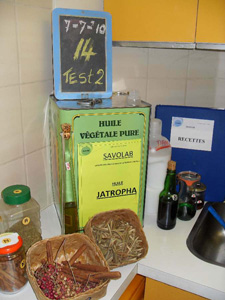 |
|||
SAVOLAB preparation – Some Raw Materials for the development of luxury Handmade Natural Soaps based on Jatropha Oil |
SAVOLAB preparation – Several specimens of luxury Handmade Natural Soaps – ready to be tested by the Consumer Panel |
SAVOLAB preparation – Two specimens of luxury Handmade Natural Soaps: Recipe 21-B <goyave fraise tropicale> |
SAVOLAB preparation Experiment 2 is going to be carried out with Soap Recipe 14 called <Spicy Cinnamon>. Its ingredients are standing ready |
|||
Interrelated Objectives and Targets – examples
A crucial element of Tomoka’s Hybrid Jatropha System is the fact that the Agricultural Program delivers the feedstock for the production of food stuffs, bio-energy, and the production of soaps and briquettes. This combination of local agriculture and agro-industry will make up the much needed impulse for all new economic and social developments in the Canton.
As has been pointed out before, the increased agricultural activities form the basis of the system. That is why the project focuses on agricultural production first. Sixty (60) percent of the unused deforested land which will be brought into exploitation has been reserved for the production of Jatropha Seeds -- the feedstock for the future Oil Mill. And forty (40) percent for maize, beans, soy, groundnuts and some other staple food crops which will feed the future small-scale factories which will turn them into baby food and other products.
All agricultural production objectives and targets are based on the availability of start capital to bring certain surfaces of unused, deforested land into cultivation each year, and on the expected crops per hectare. Several implementation scenarios have been developed. For the time being, Scenario 4 will be used to determine when and how many farmers will enter the Program. The Project called ‘Insertion’ takes care of this gradual extension. It also ensures that a series of Projects mentioned in the Social Program, is realized simultaneously. New farms, for example will get a contractual basis in which women obtain a clear role. The insertion Plan will also provide two other social innovations to the new homesteads: clean drinking water and sanitation (latrines). And last but not least: the new farming families will be incorporated into Projects of the Environment Conservation and Rehabilitation Program. Planting new useful trees around the new homestead is an example of this. Maintenance and care given to those trees are guaranteed by the fact that they will contribute to the family’s income, and that the Insertion Contracts will contain clauses which ensure that farmers will take good care of the trees on their new properties.
Other aspects which demonstrate how and when projects and their objectives are interrelated can be made clear with the Project called ‘Pilot Plantation. GuKam (Tomoka’s Initiator) has constructed this experimental plantation of 6 hectares in March 2010 with the intention to be able to produce ’high quality Jatropha propagation material and ’best agronomic practices’ in time. In other words, the Pilot Plantation will have those seeds and practices at hand when they are needed: when the Tomoka Project will be enabled to finance its operations from 2012 onwards. Another example of interrelatedness is the fact that the expected crops determine when and how much storage, transportation, and agro-industrial facilities have to be available.
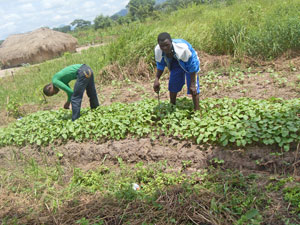 |
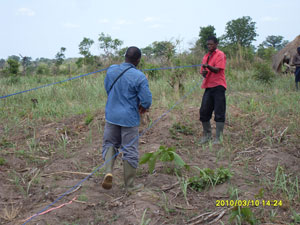 |
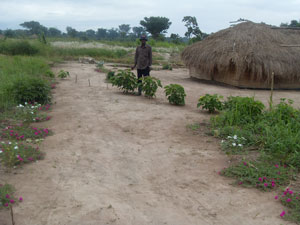 |
||
The (direct seeding) nursery on the Pilot Plantation in Avégamé serves also demonstration & training goals |
Preparing the layout of different experimental fields on the Pilot Plantation in Avégamé |
The temporary Field Office on the Pilot Plantation intends to project also <order and tidiness> |
||
Specific Objectives and targets for each of the four Implementation Programs have been included in the Download section of this website. At this stage, they cannot and should not be exhaustive because the outcomes of the Experiments being carried out on the Pilot Plantation are not yet available, and the Target Groups will certainly determine many agricultural and agro-industrial targets when they express their preferences, for example, for certain types of staple food crops, rotation schemes, and involvement in women groups which will produce and/or sell certain new products like soap, briquettes, bio-fuel and the crops of their vegetable gardens.
By way of illustrating the nature of specific agricultural targets, Tomoka presents some of them below, knowing that the outcomes of the Pilot Plantation, the availability of Funding, and the Preferences of the Target Groups may change them.
The Essential agricultural production targets which have been set on modest crop assumptions are as follows: The Project will:
- produce High Quality Jatropha Propagation Material & Best Agronomic Practices for planting at least 600 hectares of unused deforested land in the climate, soil and social-economic circumstances of the Canton during the period 2010-2013
- plant at least 600 hectares of unused deforested land with High Quality Jatropha Seeds in the period 2012-2015
- plant at least 400 hectares of unused deforested land with Staple Food Cash Crops – partly by intercropping them with Jatropha -- during the period 2012-2015
- organise the planting of 240 km of single-row Jatropha Hedges by 300-500 (subsistence) farmers in the period 2011-2014
- produce at least 18.000 kilos of Jatropha Seeds to start up a very small semi-industrial Oil Press in 2013, and increase crop volumes from 86.000 kilos in 2014 to 280.000 kilos in 2015
- produce increasing amounts of Jatropha Seeds per year until a stabilisation point of about 2.300.000 kg per year has been achieved in 2020
- produce at least 470.000 kilos of maize per year by the year 2015, and 740.000 kilos from 2018 onwards, or produce at least 976.000 kilos of beans per year by the year 2015, and 1.120.000 kilos from 2018 onwards
- produce other food crops like groundnuts and soy in sufficient quantities for the future small scale agro-industries: by introducing crop rotation schemes and improved agricultural practices to the farmers
- Agricultural demonstrations and trainings in the field of ‘Best Agronomic Practices’ for Jatropha and Intercrops will take place on GuKam’s Pilot Plantation within the context and time frame of the insertion of new farmers into the Jatropha System.
Essential agriculture related employment targets include the plan that Tomoka will:
- create new farms of 5 hectares for 100 farmer families on unused (mostly deforested) land in the period 2012-2015 while providing also new housing, basic infrastructures (like latrines, potable water, and navigable rural roads), Jatropha and staple food seeds for their participation in the Hybrid Jatropha System, and the technical and administrative support of a community worker and an agronomist.
- provide at least 300 new farming jobs for women and men on the farms referred to in target 10
- provide at least 300 new farming jobs as employees on the mid-size plantation of more than 500 ha cultivated by GuKam
- provide about 20 – 25 new jobs involved in crop storage (silos), transportation, technical support and administration.
- provide at least 25 trading jobs for women before 2015 -- for the wholesale and retail of staple foods
- provide extra income to 10 teachers if they are willing to cooperate on issues of farming, bookkeeping, agro- industry, preventive health care, and the animation of all kinds of leisure and sport clubs.
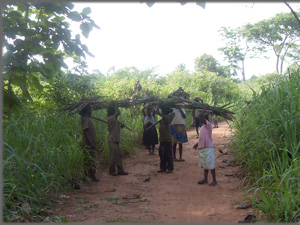 |
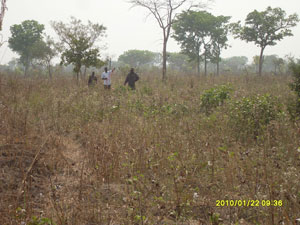 |
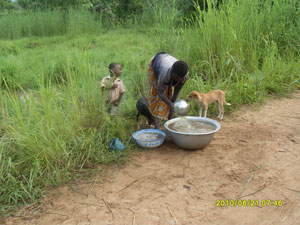 |
||
Tomoka’s promise : |
Tomoka’s promise : |
Tomoka’s promise : |
||
 Français
Français